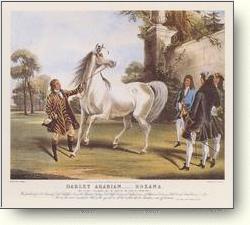
The Horses
Ancestry
Only pure thoroughbred horses are allowed to race at the competitions. All thoroughbreds are said to have the same ancestry:, three stallions: The Darley Arabian, Byerley Turk, and Godolphin Arabian.
The stallions are named after their owners - Thomas Darley, Lord Godolphin and Captain Robert Byerley. These stallions were brought to England from the Middle East in the beginning of the 17th century, with the exception of The Darley Arab, who was born in England in 1700. All horses were registered in the General Stud Book and it is only the horses that can be found in the Stud Book who are considered to be pure thoroughbred, having only pure bloodlines.
The Darley Arab

Mr. James Darley's son owned The Darley Arabian. The stallion was considered to be useless as a racehorse and actually, he never ran in a race. Instead, he was located in the stud barn.
Although he is considered to be one of the three foundation lines, his has only one offspring that we should mention- the unbeaten horse Flying Childers. However, the Darley Arabian’s male line soon became the strongest breeding line in the world. Eclipse, Darley Arabian’s most famous descendant, was foaled in 1774 (the year of a solar eclipse) and he did not race until he was nearly six years old. He was considered to be an ugly horse with a bad bone structure "and a lack of charisma". Today, he is seen as very important in the thoroughbred’s pedigree and he is recognized as the most important stallion for the thoroughbred.
The Byerley Turk
The Byerley Turk was a black stallion with an unknown pedigree. He was most likely an Arab. The legend says that he was captured at Buda during the fighting in Hungary in 1687, the horse was used as a payment for a debt to Captain Byerley. The horse was sent to England.
Like the Darley Arabian, the foals of the Byerley Turk were not very good racehorses. Instead, it was his great-grandson Herod who made his name famous. Herod (or King Herod, as he was called) was foaled in 1758. He began his racing career at the age of five and he was successful on the course and also as a stallion.
The Godolphin Arab

Godolphin Arabian was present from the Emperor of Morocco to the King of France. He became the possesion of Lord Godolphin and he was retired to stud. Like the Darley Arabian and the Byerley Turk, the Godolphin Arabian made his mark through a famous descendant. In this case, it was his grandson Matchem, a beautiful and strong bay stallion who became the father to 354 winners.
¤¤ ¤¤ ¤¤
And stallion + mare = foal
A selective breeding process that has been going on for more than 300 years. Introducing the best stallions with the best mares. And a proof of their excellent breeding on the racecourse.
The selection of horses
There are auctions with yearlings held every year, in the beginning of the autumn, so that prospective buyers can find their future winner.
Keeping a race horse
It is mostly for the rich people to keep a race-horse since it is very expensive. The cost is about £200-300 a week to keep it in training, costs for the jockey, veterinary charges, groom etc. excluded.
To keep a racehorse in Newmarket costs about £15,000 a year. Because of all these expensives, it has become more and more popular to form a syndicate, with several owners keeping a horse together, sharing the costs and happiness if the horse is successfull on the course..
The Arab influences in the sport
The thoroughbred began with Arab bloodlines and some of the most important owners are, in fact Arab sheiks; wealthy men who can afford to be single owners of racing horses. Some people claim that these Arabic people are so important to the sport that without them, everything would collapse.
The training of a race horse
The early training
The horse starts at the age of two years old. It begins its career at a flat race, and if the season turns out to be good it will continue racing the next year as well.
If a horse is not successful as a racing horse/ the career possibilities of the thoroughbred
:-)
The horse can be sold as a riding horse, and start a career as a show-jumping horse OR if the bloodlines are especially interesting it may, at a young age, become a brood mare/ stallion.
We have three main types of riding disciplines; show jumping, dressage and the three-day-eventing, and almost every horse in these disciplines have thoroughbred blood in their pedigree. For the three-day-eventing, thoroughbred is very popular!
Short word glossary
A 2-3 years old male horse is called a colt and the female a filly. When they have finished racing and are used in breeding, people use the words stallion and brood mare instead. The colts that is not up to standards are gelded and becomes – a gelding.
This year, over 13,000 horses were registered in training, and since it is only the first three or four horses who get money in the races, it is plain and simply that it is very difficult to get rich from the horse-racing industry.